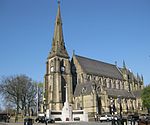Bury Bolton Street railway station
1846 establishments in EnglandBuildings and structures in Bury, Greater ManchesterFormer Lancashire and Yorkshire Railway stationsHeritage railway stations in the Metropolitan Borough of BuryPages with no open date in Infobox station ... and 4 more
Railway stations in Great Britain closed in 1980Railway stations in Great Britain opened in 1846Railway stations in Great Britain opened in 1987Use British English from January 2017

Bury Bolton Street railway station is a heritage railway station in Bury, Greater Manchester, England. Located on the East Lancashire Railway.
Excerpt from the Wikipedia article Bury Bolton Street railway station (License: CC BY-SA 3.0, Authors, Images).Bury Bolton Street railway station
Bolton Street,
Geographical coordinates (GPS) Address Nearby Places Show on map
Geographical coordinates (GPS)
| Latitude | Longitude |
|---|---|
| N 53.5934 ° | E -2.2997 ° |
Address
Bolton Street
BL9 0LQ , Buckley Wells
England, United Kingdom
Open on Google Maps










